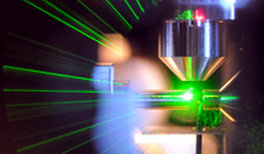Press Release
of the German Physical Society
Laserland Deutschland
Neue Ausgabe von „Physik konkret“
Bad Honnef, 16. Dezember 2010 – Der Laser, einst als „Erfindung auf der Suche nach einer Anwendung“ belächelt, ist aus unserer Gesellschaft nicht mehr wegzudenken. Fast überall, nicht nur in der Medizin, in der Datenübertragung, beim Automobil- und Flugzeugbau, im DVD-Player und als Basis für Atomuhren und GPS-Navigation sind Laser unverzichtbar. „Der Laser hat die Welt verändert“, sagt Wolfgang Sandner, Präsident der Deutschen Physikalischen Gesellschaft (DPG). „Er hilft heilen, produzieren, kommunizieren, forschen und schafft Arbeitsplätze. Deutschland gehört sowohl in der Forschung als auch in der Industrie zu den führenden Nationen.“ (Bild: T. Naeser, MPQ)
Zum Ausklang des 50. Geburtsjahres des Lasers bietet die DPG Informationen zum Thema in der neuen Ausgabe von „Physik konkret“. Das Faktenblatt mit dem Titel „Laserland Deutschland“ gibt es zum kostenfreien Download unter www.physikkonkret.de.
The German Physical Society (Deutsche Physikalische Gesellschaft e. V.; DPG), which was founded way back in 1845, is the oldest national and, with about 62,000 members, also the largest physical society in the world. As a non-profit-making organisation it pursues no economic interests. The DPG promotes the transfer of knowledge within the scientific community through conferences, events and publications, and aims to open a window to physics for the curious. Its special focuses are on encouraging junior scientists and promoting equal opportunities. The DPG’s head office is at Bad Honnef am Rhein. Its representative office in the capital is the Magnus-Haus Berlin. Website: www.dpg-physik.de
